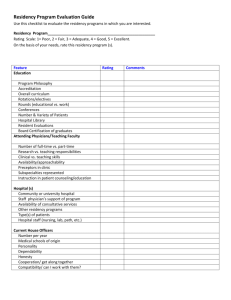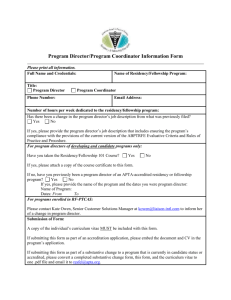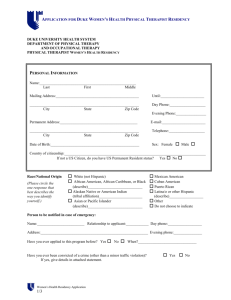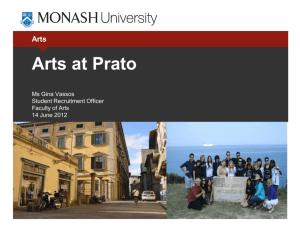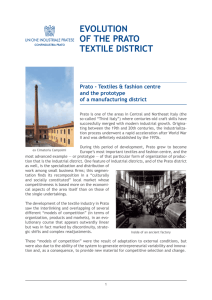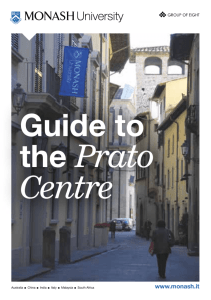Guidelines - MADA
advertisement
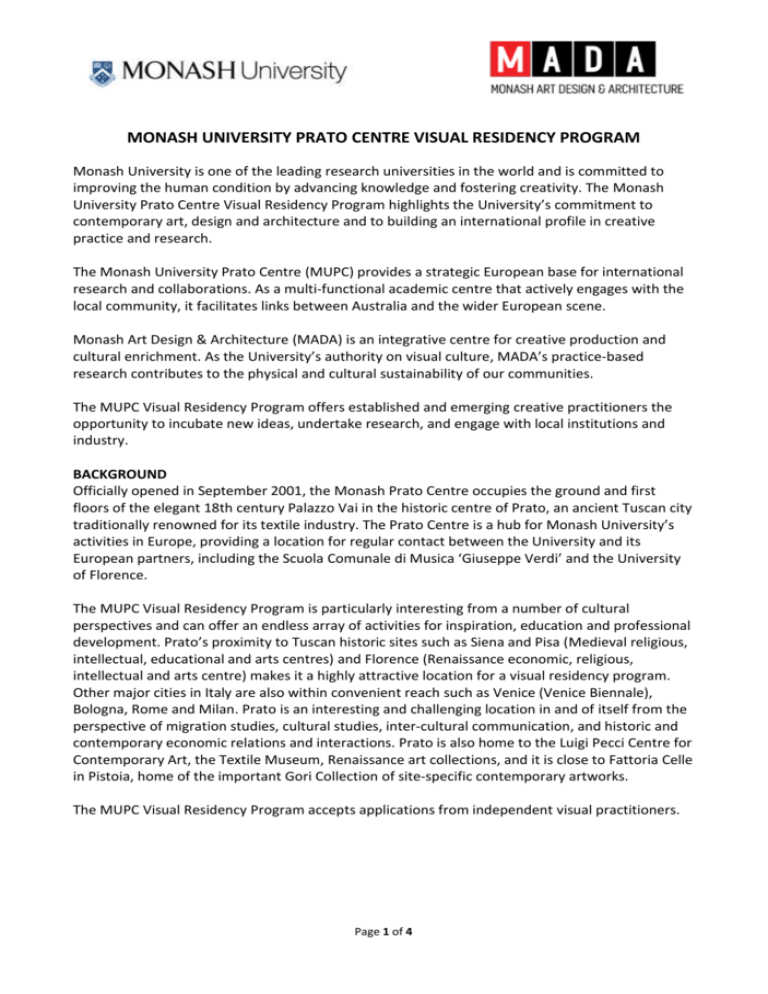
MONASH UNIVERSITY PRATO CENTRE VISUAL RESIDENCY PROGRAM Monash University is one of the leading research universities in the world and is committed to improving the human condition by advancing knowledge and fostering creativity. The Monash University Prato Centre Visual Residency Program highlights the University’s commitment to contemporary art, design and architecture and to building an international profile in creative practice and research. The Monash University Prato Centre (MUPC) provides a strategic European base for international research and collaborations. As a multi‐functional academic centre that actively engages with the local community, it facilitates links between Australia and the wider European scene. Monash Art Design & Architecture (MADA) is an integrative centre for creative production and cultural enrichment. As the University’s authority on visual culture, MADA’s practice-based research contributes to the physical and cultural sustainability of our communities. The MUPC Visual Residency Program offers established and emerging creative practitioners the opportunity to incubate new ideas, undertake research, and engage with local institutions and industry. BACKGROUND Officially opened in September 2001, the Monash Prato Centre occupies the ground and first floors of the elegant 18th century Palazzo Vai in the historic centre of Prato, an ancient Tuscan city traditionally renowned for its textile industry. The Prato Centre is a hub for Monash University’s activities in Europe, providing a location for regular contact between the University and its European partners, including the Scuola Comunale di Musica ‘Giuseppe Verdi’ and the University of Florence. The MUPC Visual Residency Program is particularly interesting from a number of cultural perspectives and can offer an endless array of activities for inspiration, education and professional development. Prato’s proximity to Tuscan historic sites such as Siena and Pisa (Medieval religious, intellectual, educational and arts centres) and Florence (Renaissance economic, religious, intellectual and arts centre) makes it a highly attractive location for a visual residency program. Other major cities in Italy are also within convenient reach such as Venice (Venice Biennale), Bologna, Rome and Milan. Prato is an interesting and challenging location in and of itself from the perspective of migration studies, cultural studies, inter‐cultural communication, and historic and contemporary economic relations and interactions. Prato is also home to the Luigi Pecci Centre for Contemporary Art, the Textile Museum, Renaissance art collections, and it is close to Fattoria Celle in Pistoia, home of the important Gori Collection of site-specific contemporary artworks. The MUPC Visual Residency Program accepts applications from independent visual practitioners. Page 1 of 4 AIMS To provide opportunities for creative practitioners to sustain and deepen their practice & research To offer and encourage engagement with local institutions and industry To provide access to significant collections, exhibitions, colleagues and practitioners in Europe To encourage independent artistic thinking, experimentation and practice To provide a place where creative practitioners can concentrate on their work, free from the distractions and duties of daily life RESIDENCY CONDITIONS Duration 3 months (1 September – 30 November 2016, subject to variation) Value approx. AUD $29,000 Inclusions Return economy airfare up to the value of $2,5001 Contribution to further travel, living expenses, materials and/or production costs to the value of $8,0002 Serviced apartment in Palazzo Vai (single or double occupancy) Private studio approx. 40 square metres Abundant natural light White-clad walls that can be hung on Power points Wi-fi Access to PC and Mac computer labs including printing facilities Access to fax and photocopier via the administrative offices Notes: Studio is not suitable for major construction as there are no workshops or hand tools. The heritage-listed parquetry floor can be covered for minor works. Some general costs associated with exhibition and public presentation, e.g., promotional material, professional translation services, refreshments Travel insurance for the period of the residency, which will be provided by Monash University’s Insurance Agent. Administrative assistance with permits for transport of artworks MUPC offers professional liaison support for interactions with the local community, but applicants should be in a position to undertake their residency in a largely self‐directed capacity. 1 Airfares will be reimbursed on the production of receipts. Payable either as contractor arrangement from invoice (with ABN) to Monash for a ‘residency fee’ or as reimbursement of receipted travel expenses, if the former, any taxes payable are the responsibility of the resident. Page 2 of 4 2 All other services, materials and expenses, including transport of artworks, private phone arrangements, laundry, tools, etc. must be covered by the resident. It is the responsibility of the resident to inform themselves of visa requirements for Italy and to make any necessary arrangements. Expectation of the practitioner Give an initial public presentation either about existing work and/or the research to be undertaken during the Residency Engage with the Monash Faculty of Art Design & Architecture’s semester programs Public engagement opportunity, eg. workshop, lecture, exhibition (of works produced during the residency, works in progress, or existing work). Acknowledge the support of the residency: Monash University logo, MADA and MUPC acknowledgement must appear on all publicity material resulting from the residency. SELECTION PROCEDURE Normally candidates will be selected through a competitive application process. The selection committee will comprise the Dean of MADA, the Head of the Department of Fine Arts, the Director of the Monash University Museum of Art (MUMA), the Chair (or nominee) of the Prato Centre Board, and the Director of the Prato Centre. The selection committee reserves the right to appoint by direct nomination. Applications are accepted from individuals with a track record of professional practice and public presentation in their field. The residency is aimed at Australian practitioners. On occasion residencies may be awarded to international practitioners. Residency applications are assessed on the merit of their proposal, in relation to the aims and objectives of the residency program, and the potential benefits to the applicant and the wider community. Decisions are also subject to the availability of the studio. Timeline 2016 July 2015 - Applications open Mid-September 2015- Applications close 15 December 2015- Announcement of successful applicant How to apply Complete the application form which includes: Proposal/project description (e.g., research, developing a body of work in Prato) (max. 400 words) Requirements, e.g., o Does your project require any special services (local project management, equipment, etc.)? o Are you planning to use very heavy or unusually large materials, specific power tools or toxic materials (such as resin)? If you have or will be applying for additional external funding to support your residency, please indicate whether the proposed funding (or independent financial support) has been approved. CV (max. 1 x A4 page) Page 3 of 4 Visual portfolio: 10 digital images in PowerPoint, or video works or excerpts (up to 8 minutes) Applications should be addressed to: Monash University Prato Centre Visual Residency Program Monash Art Design & Architecture 900 Dandenong Road Caulfield VIC 3145, Australia Email: pratoresidency@monash.edu Page 4 of 4
